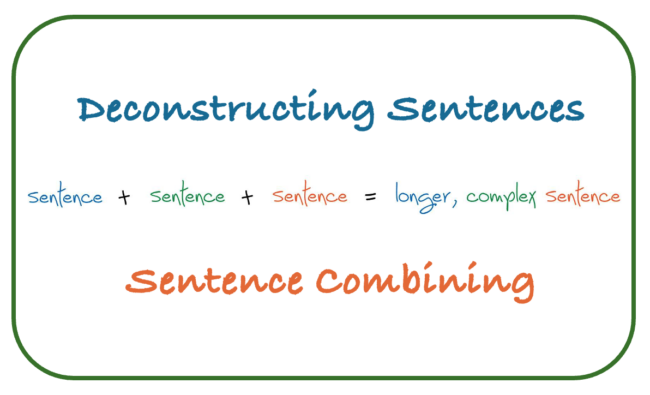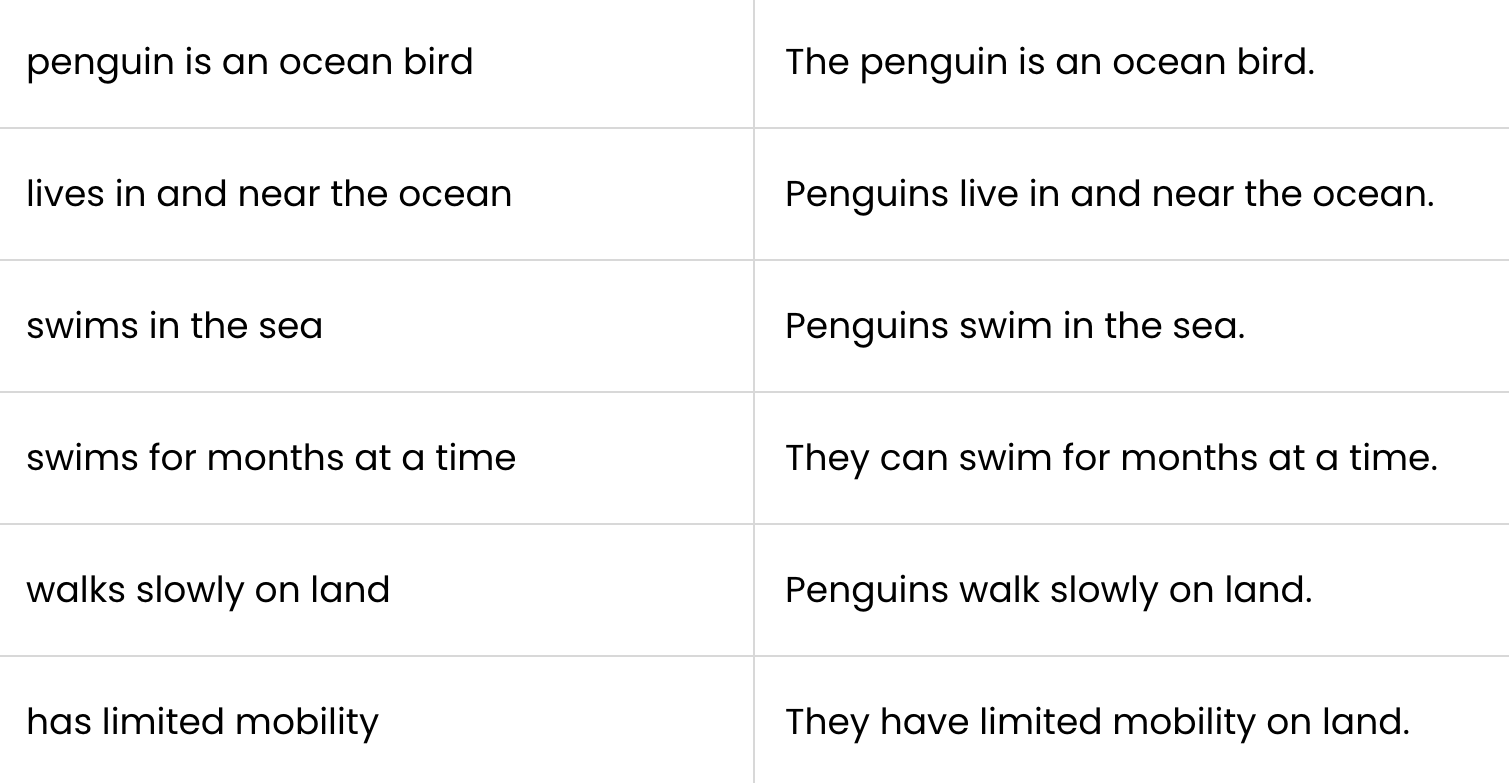Deconstructing and Combining Sentences to Support Comprehension and Writing

A sentence is a collection of words that come together to express a complete thought. Some sentences are short, and some are quite long, depending on how many ideas are included in the sentence. To comprehend a sentence, a reader must process, store in working memory, and integrate a variety of syntactic and word meaning information. A writer must be able to manipulate and add words to write a high-quality, elaborated sentence. Many students who have difficulty with reading and writing benefit from two activities that develop sentence skills: deconstructing and combining sentences (Sedita, 2020; Sedita, 2023).
Sentences and Reading Comprehension
The ability to comprehend sentences is a foundational skill for understanding written texts. One by one, sentences communicate individual ideas that, together, create meaning. Research shows that a text’s syntax (its grammatical structure) is a key predictor of how easily it can be understood (Shanahan el al., 2012; Eslami, 2014; Frantz et al., 2015), and that efficient processing of sentence structure is essential for overall comprehension (Zipoli, 2016). Proficient readers have a solid grasp of phrase structures, sentence components, and how these elements work together (Scott, 2004).
Sentences that are complex, contain multiple ideas (also known as propositions), or follow an unusual word order can pose challenges for readers—especially for students who struggle with reading. As students enter upper elementary grades, they are increasingly exposed to longer and more complex sentences, which can be even more difficult when written in discipline-specific styles, such as those found in science, history, mathematics, or literature.
Consider the following examples. Why might they be challenging for students?
- Many miles downstream on the side to which the dogs had crossed, a small cabin stood near the bank of the river, surrounded by three or four acres of cleared land, its solid uncompromising appearance lightened only by the scarlet geraniums at the window sills and a bright blue door. (from The Incredible Journey by Sheila Burnford)
- If you have trouble falling asleep at night, try avoiding technology like TVs, tablets, and video games that include a lot of action an hour before your bedtime; this might help you fall asleep more easily and enable you to be more productive in school the next day.
Sentences and Writing
Sentences, along with paragraphs, are the foundational building blocks of writing in any subject area. As each sentence is constructed, the writer combines ideas to create meaning. These sentences are then grouped by related main ideas into paragraphs, which are further organized to form longer, cohesive texts. As students progress into the upper grades, they must learn to craft more complex and elaborated sentences that reflect the higher levels of critical thinking required across different content areas. This is not an easy task. As Bruce Saddler explains, “Of the many difficulties writers encounter when engaged in the complex act of writing, crafting sentences that accurately convey the intended meaning is particularly challenging… manipulating sentences is both effortful and critical” (2012).
Students in grades 4–12 who have limited sentence-writing skills often produce shorter, less complex sentences, which reflect a lower overall quality of ideas. Their writing may include limited vocabulary and frequent grammatical errors.
Sentence Deconstruction to Support Comprehension
Proficient readers naturally break longer sentences into manageable parts and then integrate the meanings of those parts to comprehend the sentence as a whole. Sentence deconstruction is an instructional strategy designed to help students develop this skill. Deconstruction involves breaking a complex sentence into simpler, smaller ones. Students benefit when teachers identify challenging sentences in classroom texts and model how to deconstruct them to uncover their meaning.
For example, in the sentence below, there are three key parts:
- colonial soldiers wore camouflaged clothing
- British soldiers word bright red uniforms
- during the American Revolution
During the American Revolution, the colonial soldiers wore clothing that camouflaged them, unlike the British soldiers who wore bright red uniforms.
How it is done:
- The teacher selects a challenging sentence from the text students are reading – one that has multiple parts.
- Using a think-aloud strategy, the teacher models how to identify and list the different parts of the sentence. Each part is then rewritten as a phrase or a complete sentence.
Example:
The following sentence is a basic example of a sentence that has multiple parts. In the chart below the sentence, the list of sentence parts have been turned into sentences in the right column.
The penguin is an ocean bird, living in and near the ocean, comfortably swimming in the sea for months at a time, but while on land, it walks along slowly with limited mobility.

Sentence Combining for Reading and Writing
Originally developed in the 1960s and studied extensively since, sentence combining is a proven method for enhancing syntactic awareness across grade levels to support reading comprehension and writing—even into college (Strong, 1986; Graham & Perin, 2007; Saddler, 2012). It is the opposite of sentence deconstruction. This strategy helps students practice manipulating and rearranging words, expanding ideas, and clarifying meaning within sentences. Sentence combining activities can be used by teachers across all subject areas.
How It Works
Students are given two or more sentences and must combine them into a single, grammatically correct sentence. They may add or delete words and change the word order, as long as the revised sentence includes all essential information and preserves the original meaning. View two examples below. The first combines two sentences; the second combines four sentences (Sedita, 2023).
- Antarctica is the coldest of the seven continents.
- Antarctica receives very little precipitation.
- Combined sentence: Antarctica is the coldest of the seven continents and receives very little precipitation.
- Antarctica is the coldest of the seven continents.
- Antarctica’s average annual temperature in the interior is below -50C.
- Antarctica receives very little precipitation.
- Antarctica is technically a desert!
- Combined sentence: Antarctica, the coldest of the seven continents with an average annual temperature below -50C in the interior, receives so little precipitation that it is technically a desert!
Instructional Suggestions
When introducing sentence combining to students, explain that these activities will improve both their reading comprehension and writing skills. Begin with two simple sentences, then gradually increase the level of difficulty by combining more than two sentences or using longer, more complex ones. Teachers can use sample sentences from classroom texts or related content as the basis for sentence combining activities. One effective approach is to select a longer, complex sentence from a text and break it into shorter sentences for students to recombine.
Encourage Discussion About Sentence Combining: Students benefit from discussing how and why they combine sentences, as well as evaluating the resulting combinations. Through practice, guided discussions, and comparisons of student-generated sentences, they gain a deeper understanding of the various options available during the revision process (Saddler, 2012). Use the following questions to support these discussions:
- What process did you follow to combine the sentences?
- Which combination sounded best, and why?
- Which combination is the clearest?
Summary
Sentences are fundamental units of communication, consisting of words that convey complete thoughts. Engaging with both sentence deconstruction and sentence combining enhances reading comprehension and writing skills. Students benefit from practicing these activities several times a week. The best part is that these activities require minimal time – often just a few minutes or less. Teachers across various grade levels and subject areas can incorporate these activities using sample sentences derived from the content and texts being used in the classroom. This reinforces subject-area learning along with building sentence skills.
References:
- Burnford, S. (1961). The incredible journey. Hodder & Stoughton.
- Eslami, H. (2014.The effect of syntactic simplicity and complexity on the readability of the text. Journal of Language Teaching and Research, 5 (5).
- Frantz, R. S., Starr, L. E., & Bailey, A. L. (2015). Syntactic complexity as an aspect of text complexity. Educational Researcher, 44(7), 387–393.
- Saddler, B. (2012). Teacher’s guide to effective sentence writing. New York: Guilford Press.
- Scott, C. (2004). Syntactic contributions to literacy development. In C. Stone, E. Stillman, B. Ehren, & K. Apel (Eds.) Handbook of language and literacy, pp 340-363. New York: Guilford Press.
- Sedita, J. (2020). Keys to content writing. Rowley, MA: Keys to Literacy.
- Sedita, J. (2023). The writing rope: A framework for explicit writing instruction in all subjects. Paul H. Brookes.
- Shanahan, T., Fisher, D., & Frey, N. (2012). The challenge of challenging text. Educational Leadership 69(6).
- Strong, W. (1986). Creative approaches to sentence combining. ERIC Clearinghouse on Reading and Communication Skills. National Council of Teachers of English.
- Zipoli, R . (2016). Unraveling difficult sentences. Intervention in School and Clinic, 52(4), 218 – 227.

 Joan Sedita is the founder of Keys to Literacy and author of the Keys to Literacy professional development programs. She is an experienced educator, nationally recognized speaker and teacher trainer. She has worked for over 35 years in the literacy education field and has presented to thousands of teachers and related professionals at schools, colleges, clinics, and professional conferences.
Joan Sedita is the founder of Keys to Literacy and author of the Keys to Literacy professional development programs. She is an experienced educator, nationally recognized speaker and teacher trainer. She has worked for over 35 years in the literacy education field and has presented to thousands of teachers and related professionals at schools, colleges, clinics, and professional conferences.
Wow, this really hit home for me. As someone who struggled with reading comprehension in school, I think breaking down complex sentences is such a good idea. Have you tried this technique with students? What did they think?